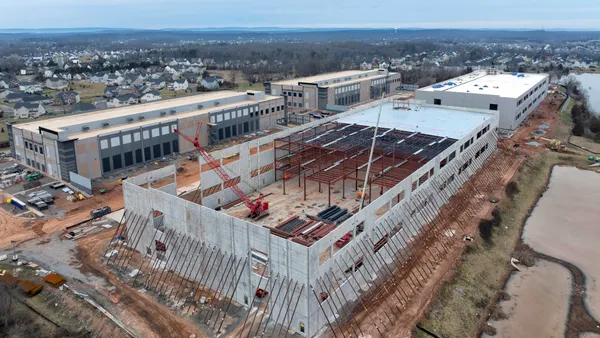Dive Brief:
- Hit by declines in all categories, the value of November construction starts dipped 5% from October to an annual rate of $563.3 billion, Dodge Data & Analytics reported. However, construction starts were still up 8% year-over-year for the January-November period, at $597.9 billion.
- Nonresidential projects saw the sharpest month-over-month decline of all the three sectors tracked by Dodge, with a 13% drop to $175.4 billion, and residential projects dipped 2% to $257.4 billion. Nonbuilding starts declined less than 1% to $130.5 billion.
- By category year-over-year, nonresidential was down 8%, but both residential (14%) and nonbuilding (23%) saw increases.
Dive Insight:
In nonresidential, the commercial buildings group fell 29% after seeing a 53% spike in October. Both retail facility projects (30%) and warehouses (13%) dropped as well. Manufacturing, however, grew 38%, due to General Motors and Mercedes-Benz auto plants, which totaled $557 million.
Multifamily was a disappointment in the residential sector, with a 6% decrease last month following a 43% upswing in October, and only six multifamily projects of $100 million or more broke ground in November, versus 11 from October.
Nonbuilding’s highway and bridge category was up 16% with a $315 million highway reconstruction project in Milwaukee. Public works shot up 93%, largely due to a $1.6 billion subway extension in Los Angeles. However, these projects were not enough to keep nonbuilding out of the negative, as water supply (31%), sewer (42%), and electric power and gas facilities (59%) all took a plunge.
Robert Murray, Dodge chief economist, said in a statement that "on balance, October and November do show improvement after the subdued activity in late summer."
Murray warned last month that the lack of a long-term highway funding bill from Congress could significantly affect the sector, but a five-year bill, with funding for 2016 at 5% above last year’s total, was finally passed earlier this month.
Before the new bill was a done deal, Washington came up with one short-term measure after another to keep payment to contractors flowing and highway projects alive. Although there is a long-term funding solution in place now, the Associated General Contractors of America cited the uncertainty generated by lack of a bill as a reason for past low construction employment numbers. Construction equipment giant Caterpillar even reported that Congress' inability to pass a bill had affected the company's sales.










